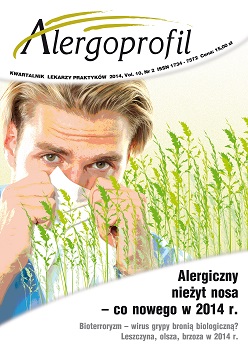Could influenza be a possible biological warfare agent? Part I
Main Article Content
Abstract
Knowledge of bioterrorism in society, not only in Poland but also in the world, is scarce. A very important element in preventing and effectively counteracting the effects of biological destruction agents is to have an efficient and integrated epidemiological and virological surveillance system, as well as networks of specialized microbiological-virological accredited laboratories able to conduct rapid diagnosis. In addition, an important issue is to adequately train and equip emergency service personnel and health services acting under the developed procedures. The study in part I shows that the attacks with the use of the flu virus may have different results, from epidemic to psychological terror associated with it. The data presented are based on resources of the authors which have been done so far and on contemporary literature and oral presentation was presented at The International Conference - Advances in Pneumology. October 25-26, 2013 Kassel, Germany [1]
Downloads
Article Details
Copyright: ? Medical Education sp. z o.o. This is an Open Access article distributed under the terms of the Attribution-NonCommercial 4.0 International (CC BY-NC 4.0). License (https://creativecommons.org/licenses/by-nc/4.0/), allowing third parties to copy and redistribute the material in any medium or format and to remix, transform, and build upon the material, provided the original work is properly cited and states its license.
Address reprint requests to: Medical Education, Marcin Kuźma (marcin.kuzma@mededu.pl)
References
2. Wright PE, Webster RG. Orthomyxoriruses. In: Knipe D.M., Howley P.M. (Eds). Fields Virology. 4th ed. Lippincott Williams & Wilkins, Philadelphia 2001: 1533-1579.
3. Krug RM. The potential use of influenza virus as an agent for bioterrorism. Antiviral Research 2003, 57: 147-150.
4. Wojtyniak B, Goryński P, Moskalewicz B (Eds.). Sytuacja zdrowotna ludności Polski i jej uwarunkowania [The health situation of the Polish population and its determinants]. NIZP-PZH 2012.
5. Reid AH, Taubenberger JK, Fannning IG. The 1918 Spanish influenza: integrating history and biology. Microbes Infect 2001, 3: 81-87.
6. Smith W, Andrewes C, Laidlaw P. A virus obtained from influenza patients. Lancet 1933, 225: 66-68.
7. Francis T. Transmission of influenza by a filterable virus. Science 1934, 80: 457-459.
8. Claas EC, Osterhaus AD, van Beck R et al. Human influenza A H5N1 virus related to a highly pathogenic avian influenza virus. Lancet 1998, 351: 472-477.
9. Suarez DL, Perdue MI, Cox N et al. Comparisons of highly virulent H5N1 influenza A viruses isolated from humans and chickens from Hong Kong. J Virol 1998, 72: 6678-6688.
10. Subbarao K, Klimov A, Katz J et al. Characterization of an avian influenza A (H5N1) virus isolated from a child with a fatal respiratory illness. Science 1998, 279: 393-396.
11. Hatta M, Gao P, Halfmann P et al. Molecular basis for high virulence of Hong Kong H5N1 influenza A viruses. Science 2001, 293: 1840-1842.
12. Webster RG, Guan Y, Petris M et al. Characterization of H5N1 influenza viruses that continue to circulate in geese in south-eastern China. J Virol 2002, 76: 118-126.
13. Fodor E, Devenish L, Engelhardt OS et al. Rescue of influenza A virus from recombinant DNA. J Virol 1999, 73: 9679-9682.
14. Neumann G, Watanabe T, Ito H et al. Generation of influenza A viruses entirely from cloned cDNAs. Proc Natl Acad Sci USA 1999, 96: 9345-9340.
15. Hatta M, Neumann G, Kawaoka Y. Reverse genetics approach towards understanding pathogenesis of H5N1 Hong Kong influenza A virus infection. Philos Trans R Soc Lond B Biol Sci 2001, 356: 1841-1843.
16. Hay AJ, Woldenholme AJ, Skehel JJ et al. The molecular basis of the specific anti-influenza action of amantadine. EMBO J 1985, 4: 3021-3024.
17. Air GM, Ghate AA, Stray SJ. Influenza nauramidase as for antivirals. Adv Virus Res 1999, 54: 375-402.
18. Li MI, Rao P, Krug RM. The active sites of the influenza capdependent endonuclease are on different polimerase subunits. EMBO J 2001, 20: 2078-2086.
19. Lamb RA, Krug RM. Orthomyxoviridae: the viruses and their replication. In: Knipe D.M., Howley P.M. (Eds). Fields Virology, 4th ed. Lippincott Wiliams & Wilkins, Philadelphia 2001: 1487-1532.
20. Li ML, Ramirez C, Krug RM. RNA-dependent activation of primer RNA production by the influenza virus polimerase: different regions of the same protein subunit constitute the two required RNA-binding sites. EMBO J 1998, 17: 5844-5852.
21. Chen Z, Li Y, Krug RM. Influenza A virus NS1 protein targets poly(A)binding protein II of the cellular 3?-end processing machinery. EMBO J 1999, 18: 2273-2283.
22. Li Y, Cheng ZY, Wang W et al. The 3?-end processing factor CPSF is required for the splicing of single-intron pre-mRNAs in vivo. RNA 2001, 7: 920-931.
23. Kim MJ, Latham AG, Krug RM. Human influenza viruses activate an interferon-dependent transcription of cellular antiviral genes: outcome with influenza A virus is unique. Proc Natl Acad Sci USA 2002, 99: 10096-10101.
24. Koblentz GD.: From biodefence to biosecurity the Obama administration?s strategy for countering biological threats: Int. Affairs 2013, 1(88): 131-148.
25. Evans NG Great expectations-ethics, avian flu and the value of progress. J Med 2013, 39(4): 209-213.
26. Tomassini J, Selnick H, Davie ME et al. Inhibition of cap (m7GpppXm)-dependent endonuclease of influenza virus by 4-substituted 2,4-dioxobutanoic acid compounds. Antimicrob Agents Chemother 1994, 38: 2827-2837.
27. Tomassini JE, Davies ME, Hastings J et al. A novel antiviral agent which inhibits the endonuclease of influenza viruses. Antimicrob Agents Chemother 1996, 40: 1189-1193.

